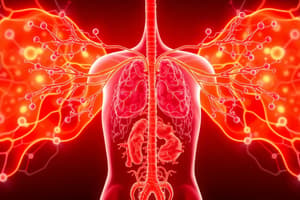Podcast
Questions and Answers
What role do osteoclasts and osteoblasts play in bone health?
What role do osteoclasts and osteoblasts play in bone health?
Osteoclasts mediate bone resorption by breaking down the bone matrix, while osteoblasts are responsible for bone formation by laying down new organic minerals.
How does vitamin D contribute to calcium absorption and bone strength?
How does vitamin D contribute to calcium absorption and bone strength?
Vitamin D is converted into calcitriol in the kidneys, which helps with the reabsorption of calcium, strengthening bones.
What are the key differences between Type 1 and Type 2 diabetes?
What are the key differences between Type 1 and Type 2 diabetes?
Type 1 diabetes is characterized by the autoimmune destruction of pancreatic beta cells resulting in no insulin production, while Type 2 diabetes involves insufficient insulin production and cellular insulin resistance, often related to obesity.
What symptoms are commonly associated with hyperglycemia?
What symptoms are commonly associated with hyperglycemia?
What distinguishes peptide hormones from steroid hormones in terms of their solubility and receptor location?
What distinguishes peptide hormones from steroid hormones in terms of their solubility and receptor location?
What is the primary role of the hypothalamus in the endocrine system?
What is the primary role of the hypothalamus in the endocrine system?
Why can't peptide hormones be administered orally?
Why can't peptide hormones be administered orally?
What is the significance of eicosanoids in the endocrine system?
What is the significance of eicosanoids in the endocrine system?
Explain the role of adenylyl cyclase in the action of water-soluble hormones.
Explain the role of adenylyl cyclase in the action of water-soluble hormones.
How does the structure of steroid hormones allow them to easily cross the plasma membrane?
How does the structure of steroid hormones allow them to easily cross the plasma membrane?
What hormones are released by the posterior pituitary, and what is their source?
What hormones are released by the posterior pituitary, and what is their source?
Describe the primary hormones secreted by the adrenal cortex and their types.
Describe the primary hormones secreted by the adrenal cortex and their types.
What is the role of ACTH in the adrenal cortex?
What is the role of ACTH in the adrenal cortex?
How does negative feedback influence hormone regulation in the endocrine system?
How does negative feedback influence hormone regulation in the endocrine system?
What factors affect the synthesis and release of thyroid hormones?
What factors affect the synthesis and release of thyroid hormones?
Explain the physiological effects of T3 on metabolism.
Explain the physiological effects of T3 on metabolism.
What distinguishes primary from secondary hyperthyroidism/hypothyroidism?
What distinguishes primary from secondary hyperthyroidism/hypothyroidism?
How does the thyroid hormone impact cardiovascular health?
How does the thyroid hormone impact cardiovascular health?
Flashcards
Cortical Bone
Cortical Bone
A dense and hard type of bone tissue found in the outer layer of bones.
Trabecular Bone
Trabecular Bone
A lighter and spongy type of bone tissue found inside bones, providing strength and flexibility.
Bone Resorption
Bone Resorption
The process of breaking down bone tissue, mediated by osteoclasts.
Bone Formation
Bone Formation
Signup and view all the flashcards
Diabetes
Diabetes
Signup and view all the flashcards
Peptide/protein hormones
Peptide/protein hormones
Signup and view all the flashcards
Amino Acid Derivative Hormones
Amino Acid Derivative Hormones
Signup and view all the flashcards
Steroid Hormones
Steroid Hormones
Signup and view all the flashcards
Water-soluble Hormones
Water-soluble Hormones
Signup and view all the flashcards
Lipid-soluble Hormones
Lipid-soluble Hormones
Signup and view all the flashcards
Hypothalamus
Hypothalamus
Signup and view all the flashcards
Pituitary Gland
Pituitary Gland
Signup and view all the flashcards
Endocrine System
Endocrine System
Signup and view all the flashcards
What hormones are released by the posterior pituitary?
What hormones are released by the posterior pituitary?
Signup and view all the flashcards
What hormones are released from the anterior pituitary?
What hormones are released from the anterior pituitary?
Signup and view all the flashcards
What types of hormones does the adrenal cortex release?
What types of hormones does the adrenal cortex release?
Signup and view all the flashcards
What does the adrenal medulla release?
What does the adrenal medulla release?
Signup and view all the flashcards
What regulates thyroid hormone release?
What regulates thyroid hormone release?
Signup and view all the flashcards
What is the role of the thyroid gland?
What is the role of the thyroid gland?
Signup and view all the flashcards
What are hyperthyroidism and hypothyroidism?
What are hyperthyroidism and hypothyroidism?
Signup and view all the flashcards
What's the difference between primary and secondary hyper/hypothyroidism?
What's the difference between primary and secondary hyper/hypothyroidism?
Signup and view all the flashcards
Study Notes
Endocrine System Overview
- Endocrine hormones travel in the blood to receptors, impacting them locally or distantly.
- Response time is minutes to hours.
- Each hormone fits precisely into its receptor.
Hormones
Peptides/Proteins
- Chains of amino acids.
- Cannot be administered orally (digested in the GI tract).
- Examples: oxytocin, insulin.
Amino Acid Derivatives
- Synthesized from tyrosine.
- Examples: thyroid hormones, adrenaline, dopamine.
Steroids
- Derived from cholesterol.
- Examples: testosterone, estrogen.
Eicosanoids
- Signaling molecules.
- Polyunsaturated fatty acid derivatives.
- Example: PGE2.
Hormone Solubility and Transport
- Water-soluble hormones (peptides and proteins) circulate freely in the blood.
- Lipid-soluble hormones (steroids and thyroid hormones) travel bound to transport proteins.
- Water-soluble hormones bind to receptors on the cell surface.
- Lipid-soluble hormones bind to receptors in the cytoplasm.
Water-Soluble Hormone Examples
- Amines
- Peptides/proteins
- Noradrenaline
- TSH
- Growth hormone
Water-Soluble Hormone Binding
- Binds to membrane receptor.
- Activates a G protein.
- Activates adenylyl cyclase.
- Converts ATP to cAMP.
- Activates protein kinases.
- Phosphorylates proteins, altering cell activity.
Lipid-Soluble Hormone Examples
- Testosterone
- Progesterone
- Cortisol
- Aldosterone
Lipid-Soluble Hormone Binding
- Diffuses through the plasma membrane.
- Binds to receptor in cytoplasm, forming a complex.
Studying That Suits You
Use AI to generate personalized quizzes and flashcards to suit your learning preferences.



